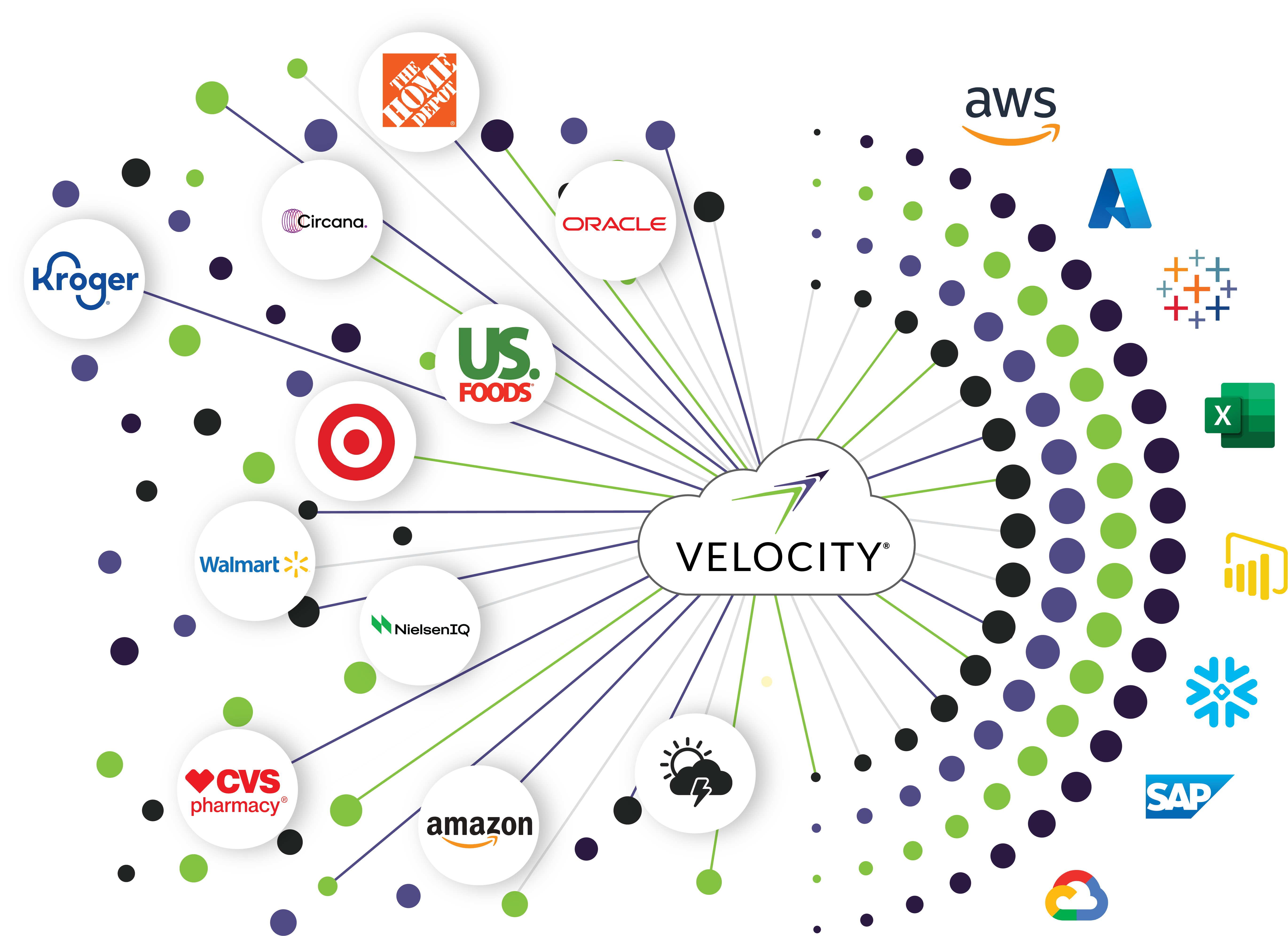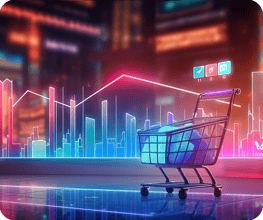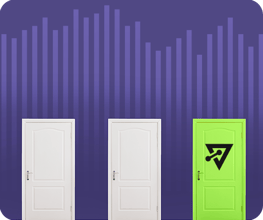
How CPGs Can Harness the Power of Vendor Portals
Table of Contents
- What Is a Vendor Portal?
- Retailer Portal Challenges, Limitations, and Barriers
- How to Get the Most Out of Vendor Portals and Retail Data
- When Selling Through Multiple Retailers
- Don’t Go It Alone
Vendor portals (also referred to as supplier portals, retailer portals, retailer data portals, or retail data portals) house a treasure trove of data that enables consumer packaged goods (CPG) companies to better analyze and manage their business and optimize performance with the retailers they sell through. Depending on the retailer, suppliers can access retail point-of-sale (POS) and inventory data, reports, forecasts, business intelligence (BI) tools, and additional information that is essential for generating valuable insights necessary for informing critical business decisions.
With a more comprehensive view of key retail metrics, consumer brands can make data-driven sales, marketing, inventory, and replenishment decisions that ensure on-shelf availability, propel sales, and drive gross margin return on investment. Brands are also able to make value-add recommendations to their retailer partners to increase trust, improve collaboration, and strengthen relationships.
Successful CPG companies are the ones who know how to get the most out of vendor portals and their respective retail data. However, harnessing the power of both does not come without challenges and limitations.
Although most retailer data portals serve a similar purpose, they differ significantly in various aspects such as the types of data or performance metrics they offer, the granularity of data, data distribution methods, and user interfaces. Without industry standards for data structure or distribution, suppliers must develop unique processes and employ sophisticated software solutions for efficient data collection, cleansing, and harmonization across retailers and retail data sources.
In this article we will explore the importance and challenges of vendor portals, the varying data needs within a CPG, and how CPG companies can get the most out of their retailer partners’ data portals and optimize the usage of their retail data.
WHAT IS A VENDOR PORTAL?
At its most basic level, a vendor portal is an online source or platform where suppliers can access retailers’ POS, inventory, and supply chain data; performance metrics; and various reports, tools, and functionalities in one location. Portals facilitate numerous decisions and activities crucial for streamlining business operations and improving retailer-supplier collaboration and collaboration within a CPG company’s own four walls.
Retailer portals typically pull data from a retailer’s data warehouse. Simpler portals may only offer downloads of canned reports and simple data files while more advanced portals may offer BI tools for creating new analytics and streamlining data downloads. Also, newer API portals are emerging that allow suppliers to connect their own systems to retailers’ systems and automate data transfers.
Why are vendor portals important to consumer brands?
In an increasingly digital age and a fast-paced, innovative retail world (including both brick-and-mortar and e-commerce), more and more CPG companies and retailers are turning to online solutions and modern data platforms to improve their data analytics, streamline their processes, improve efficiency, and enhance the consumer or shopper experience.
Central to all of that is the supplier-retailer relationship. Both parties, if they want to remain competitive and profitable, need to constantly adapt and improve—and a vendor portal is an indispensable tool for enhancing the relationship to achieve those goals.
Vendor portals are important to suppliers because, at their core, they can simplify and automate some labor-intensive, time-consuming, manual tasks and processes that are prone to human error and can be costly (and frustrating!). Effective use of these portals leads to optimized retail data analysis, deeper insights, more strategic decision-making, enhanced communication, and overall efficiency in the supplier-retailer relationship, all of which are crucial to achieving stability in the market and sustainable growth.
Also, when portals provide both store and online activity, they can improve sales forecasting, warehouse inventory management, and order fulfillment.
What data and analytical needs can vendor portals fulfill for suppliers?
Depending on their retail channels and product categories, as well as whether they sell through physical stores, online, or both, CPGs have different uses for retailers’ data and different analytical needs for sales, marketing, logistics, finance, and supply chain teams. Here are a few examples of how suppliers may use data obtained from vendor portals:
- Although sales and account teams can use retailer portals to produce reports to share with individual retail buyers, the sales department, as a whole, needs to track and understand sales across regions and countries by acquiring and consolidating sales data from many different retail data sources. These teams also require historical sales data for effectively managing new product launches, working with logistics personnel, and predicting promotional and holiday activity to accurately meet consumer demand.
- Executives and financial teams need to monitor and predict corporate revenue and manage relationships with retailers at a top level.
- Logistics teams manage warehouses and order fulfillment, and being able to accurately monitor and adjust retailer inventories can avoid cuts and cancellations.
- In the past, Demand Planning would rely on historical orders received from retailers for developing production forecasts. Now, they can incorporate retailer POS data (consumer demand) for more accurate forecasts. This requires automating the acquisition, cleansing, and integration of various retail data sources to better enable forecasting engines.
- Sales, marketing, and demand planning teams need to work together to manage future production and sales more effectively. Thus, being able to quickly and easily acquire and manage data across channels and retailers is critical to success.
RETAILER PORTAL CHALLENGES, LIMITATIONS, AND BARRIERS
Despite providing access to valuable information and offering various reporting capabilities and functionality that enable CPG companies to garner key insights needed to run their business, retailer portals can fall short in several areas. Here are some of the more prominent issues CPGs experience:
Unintuitive Interface
An effective user interface should make the user's experience easy and intuitive and require minimum effort on the user's part to receive the desired outcome; however, this is not always the case with retailer portals, especially larger, more robust ones such as Walmart’s Retail Link and Target Partners Online.
Complex navigation alone makes it difficult to find the data or reports needed and leads to a steep learning curve for many new users.
Speed and Time to Actionable Insights
Not being able to easily obtain the information required because of a subpar interface or waiting longer than necessary for reports because of slow, outdated software can be quite irritating for anyone. What is worse, though, is that it inhibits timely data retrieval and analysis, further delaying the ability to generate and act upon meaningful insights.
Lack of Reporting Capabilities
Although many portals can provide reports, they are not stand-alone reporting or retail analytics tools, nor do they always provide a comprehensive view of the core metrics you need to make fact-based sales, marketing, demand planning, inventory, and supply chain decisions to grow your business.
If you are pulling reports out of your portals, you are more than likely analyzing your data in Excel, which is a tedious, inefficient process. Also, the POS and inventory data may be incomplete or inaccurate, and manually downloading and manipulating data can result in costly errors for both a supplier and its retailer partners.
Guidance and Support Requirements
The intricacies of vendor portals such as Retail Link, Partners Online, and Amazon Vendor Central can lead to users requiring help or sometimes formal training to fully leverage the platforms and optimize their efforts. This may require additional costs and external resources.
No Data Democratization
Each portal interface requires specific knowledge, and often, there are only a handful of individuals at a CPG company who truly know the ins and outs of working with the larger, more complex vendor portals. Although these individuals may be well versed in best practices and workarounds for the "finickiness" and nuances of these tools, they also hold the keys to the castle—that is, they are the only ones who possess the institutional knowledge of not only how to access the data and reports but also how to effectively leverage the portals.
Therefore, important data is not democratized, and these individuals could actually be a bottleneck at the gateway to the data and insights. On top of that, if data is not democratized, companies run the risk of losing that institutional knowledge should something happen to an individual or they leave the company.
Absence of APIs
Despite the emergence of more APIs, portals without an API make it more difficult for suppliers to ingest and integrate data and systems. Without automated data retrieval and analysis, insights are less readily available, and suppliers run the risk of delaying critical business decisions that could significantly impact their bottom line.
HOW TO GET THE MOST OUT OF VENDOR PORTALS AND RETAIL DATA
1. Automate Manual, Mundane, Monotonous Tasks and Processes
Would you rather start your workday logging into multiple vendor portals to manually pull reports and then waiting hours before the data is ready for analysis (more than likely in Excel)? Or would you rather sit down at your desk and have clean, harmonized daily retail data for all your retailers and products at your fingertips so you can dive right into the retail data analytics you need to generate timely insights?
Data and business analysts, and even sales, marketing, and supply chain team members, can find themselves spending an exorbitant amount of time—especially within Retail Link, Target Partners Online, and Amazon Vendor Central—navigating the platforms to locate the desired data, running reports, and waiting longer than they should to get the information. This is valuable time that could be much better spent actually analyzing the data and understanding retailer and product performance so you can make intelligent business decisions to grow your business.
With Retail Velocity and VELOCITY®, our cloud-based retail data platform for consumer brands, you can fully automate the data ingestion, cleansing, harmonization, and analysis of daily POS and inventory data at a store and SKU level from any retail data source. Time is money, and by automating and eliminating tedious, routine, and manual tasks and processes, you can spend your newly found free time much more efficiently—by uncovering the insights and making data-driven decisions that help generate revenue and reduce costs for you and your retailers.
2. Shirk the Quirks of Vendor Portals
Some suppliers may view vendor portals as a necessary evil, but they truly are a valuable resource when managed properly. However, as we discussed above, they can be finicky and have their own nuances and quirks, which can lead to frustration on the user’s part and more time wasted from dealing with those quirks.
If a user is spending too much time trying to find a particular data point or metric or is performing a workaround, that is time that could be spent more wisely on value-add activities. Also, users of these tools often encounter data that does not “add up,” resulting in time spent trying to figure out the problem instead of obtaining insights to solve problems. When data and reports do not make sense, it can put doubt into the user’s mind as to the validity of the data, and if decisions are based on that data, it could end up being costly.
By automating retail data ingestion and integration with a solution like VELOCITY®, suppliers can say goodbye to managing the nuances of each portal and stop relying on the institutional knowledge of a select group and focus on leveraging retail data and retail analytics that are complete, accurate, and dependable. When brands make strategic decisions based on precise, trustworthy data and insights, they greatly improve their odds of being successful.
3. Democratize Your Data and Decisions
Suppose you have a meeting in a few days with your Target buyer to discuss a new product launch. Naturally, you want to go in armed with historical POS data on how successful previous product launches have been and what your new product sales forecast is for that retailer and each store location. You want to tell a compelling data story and get your buyer to stock the product, but there is just one problem—your data analyst is on PTO for the next 10 days. That is the end of that story.
When you rely on a handful of individuals who are the gatekeepers of crucial data and analytics, you run the risk of not having the information you need, when you need it, to make business decisions that can positively impact your business. Inhibiting your ability to garner actionable insights needed to gain trust with your retailer partners and improve your relationships could cost you valuable shelf space and result in lost promotional opportunities, sales, and revenue.
If you want to make timely, confident, data-driven decisions, well, then you need … the data! And given the need for companies to achieve rapid digital transformation and effectively manage the digital customer journey in a world of ever-changing demand, suppliers need accurate retail data, reporting, analytics, and insights as quickly as possible.
What could also speed up time to insights is automation of your analytics and opening access to core performance metrics and analytics to key business teams. When you automate POS and inventory data analytics, it allows your analysts to focus their time on uncovering insights—and not on data wrangling—that will improve your business operations. It also gets actionable insights into the hands of your key decision makers more quickly. Most business team members probably do not have the technical and data expertise to optimally use the larger vendor portals, therefore, by increasing and democratizing access to reporting, analytics, and actionable insights, you increase the power and value of your data to the individuals who need it most.
4. Chart the Right Course with the Right Data
Nobody wants to make important sales, marketing, financial, or supply chain decisions based on outdated data, nor do they want to scroll through hundreds (even thousands!) of rows of data in a spreadsheet to find a nugget or two of insights. That is why it’s critical for brands to have the most recent, accurate, and reliable retail data in an easily digestible—and accessible—format to make informed decisions.
If you rely solely on the reports generated via retailer portals, you run into a few issues. One, you will have to manually download and compile data from text files, CSV files, and more, which isn’t going to happen in five minutes. Secondly, the information you download will more than likely not have any data visualizations—no graphs, charts, or maps. That leaves you with having to create your own static data visualizations in Excel that you will need to update manually with new or updated data. By the time this is complete, and you get the information to the key stakeholders, the data will be out of date and the insights derived from that data will not be as relevant or reliable.
With VELOCITY®, you can automatically extract and harmonize daily POS and inventory data at an item-store level from any retailer or distributor portal—and seamlessly integrate it with syndicated data and ERP data—so you have complete visibility into retailer and product performance across all your retailer partners. With intuitive dashboards and automatic data updates, you can quickly and easily identify trends, patterns, and outliers to help you reduce out-of-stocks, improve retail execution, optimize new product launches, and drive profitable sell-through. And when equipped with near real-time, granular retail data and insights, you will be better positioned to effectively respond and adapt to changes in consumer demand and market conditions, giving you a competitive advantage.
5. Focus, Focus, Focus—on Opportunities, Not Problems
There are no such things as problems—only opportunities. It is unrealistic to think that consumer brands and retailers will not encounter some “opportunities” to rectify issues with product availability and retail execution or have opportunities to meet consumer demand more effectively, increase market share, and strengthen brand loyalty. Consider that it is a fast-paced, need-it-now, what-can-you-do-for-me world and you can then understand why consumer brands need to consistently understand consumers’ expectations, meet changing consumer preferences, and adjust to shifts in market conditions immediately.
When you combine all the data from all the portals (as well as data from other sources) you might work with, you’re facing a mountain of information that can be overwhelming, unmanageable, or even confusing about where to focus your efforts and problem-solving actions. But when you have clean, harmonized retail data for all your retailers—and a software solution such as VELOCITY® that provides alerts and exception reports—you can accurately identify critical business issues or risks, growth opportunities, and opportunities to improve retailer relationships.
By managing your business with automated alerts and exception reporting, instead of spending hours upon hours digging through Excel to maybe find a few issues, you can quickly identify problem areas at a store and item level that need your attention—right now. This is important for your relationship with any retailer, but it becomes even more significant for your relationships and business with Walmart, Target, Amazon, Kroeger, and other large retailers.
WHEN SELLING THROUGH MULTIPLE RETAILERS
All the tips discussed above apply to any single retailer’s portal you are working in and when put into play will improve a CPG company’s business in several areas. However, when selling through multiple retailers and working in multiple portals, the challenges and complexities are compounded and the need for an automated retail data platform and retail data analytics best practices intensifies.
If you’re manually gathering data, pulling reports, and trying to compile all of it to analyze cross-retailer performance and gain some actionable business intelligence then you’re wasting IT, analyst, and potentially sales and marketing time that could be spent surfacing insights, making strategic decisions, and implementing plans that drive profitable growth.
When brands can eliminate laborious tasks and processes across vendor portals and empower their sales, marketing, and supply chain teams with near real-time data that is trustworthy and insights that are dependable they gain a tremendous competitive advantage and the ability to make the right decisions that will propel their business forward.
DON'T GO IT ALONE
Vendor portals—managing them effectively and fully leveraging the data they contain—are central to the success and growth of CPG companies. Trying to manage them all on your own, though, can be not only difficult but also frustrating, inefficient, and costly. So, why waste your time, money, and resources swimming and potentially drowning in a sea of retail data when you can hop on board a proven retail data management solution that can keep you afloat, keep you moving in the right direction, and ensure you reach your desired business outcomes.
Our VELOCITY® retail data platform for consumer goods companies eliminates the heavy lifting of you collecting, cleaning, and harmonizing POS, inventory, and third-party data from any retail data source. With more than 600 retail data adaptors, VELOCITY allows you to automatically retrieve the most granular daily data at scale and seamlessly integrate accurate data into VELOCITY’s dashboards and analytical tools or feed that data into your own data warehouse, data lake, or BI tools of choice.
With the most powerful, up-to-date data ready every morning, brands can optimize their data reporting and analysis to gain actionable insights and improve their decision-making processes to optimize product and retailer performance and grow their business.
To learn more about how Retail Velocity can help you gain the most value from your retailer partner portals and generate the insights you need to optimize your business, contact us today.




